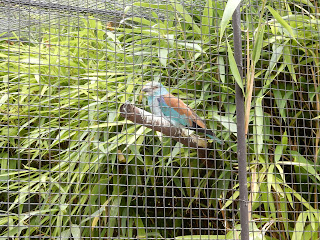As mentioned in my previous post, I did not get to visit the Ménagerie at Jardin des plantes during the third day of IPC 2018. So on the fourth day of the conference, my labmate Juan Benito Moreno and I decided to skip out on the early afternoon talk sessions to see it. The Ménagerie is quite a small zoo; one can easily see all the exhibits in the space of two hours. (Though I went on a second solo visit on the fifth day after the conference concluded, just so I could obtain better images of some animals. This post contains photos from both trips.)
The Ménagerie is one of the oldest public zoos in the world. Being so small, exhibit space is accordingly restricted. To its credit, the Ménagerie mostly lacks very large-bodied animals, instead focusing on smaller and medium-sized species that can live more comfortably in the enclosures. In many cases, these species are relatively rare in captivity and have successfully bred at the zoo, so I would still consider the Ménagerie worth a visit despite its small size. There were nonetheless a few exhibits that I felt were too small for the inhabitants, with the primate and parrot enclosures being the main offenders.
On both visits I got good views of this red panda lying high up on its climbing frame.
Some lowland anoa. Bovid diversity was one of the highlights at the Ménagerie (though not being a bovid fan in particular, I didn't go to lengths to photograph all of them).
A white-naped crane.
A white-fronted woodpecker.
A snow leopard.
This Malayan tapir had one of the more spacious exhibits in the zoo.
Probably the greatest highlight to me personally was seeing these MacQueen's bustards. We got to see one of the males perform its unusual courtship display!
Above the bustards perched a European roller and a Eurasian hoopoe. Picocoracians unite!
Next door was the zoo nursery, in which the only inhabitant I could see was this young white-naped crane.
In the same building as the nursery was an exhibit for tree kangaroos and brush-tailed bettongs, though the tree kangaroos chose not to show themselves. I did see a bettong sleeping in a corner, but it wouldn't have made for a particularly photogenic shot. (You may be able to spot it in the photograph below if your eyes are keen.) Quite a few mice scurried about, probably taking advantage of the food and hiding spots available.
A pair of blue cranes.
Some bharal (also known as blue sheep), including a kid.
A great green macaw.
A palm-nut vulture. Unusually for a bird of prey, a large proportion of its diet consists of fruits.
A king vulture.
A red-headed vulture, one of several Asian vulture species experiencing alarming population declines, threatened by the use of the veterinary drug diclofenac.
A red-vented cockatoo.
A palm cockatoo.
A southern cassowary.
Some yellow-throated martens. These mustelids hunt in pairs and sometimes in small groups, allowing them to hunt relatively large prey such as young deer. The glare on the glass was strong that day...
Some great gray owls.
A tawny frogmouth. As you might infer from my IPC poster, this species is of particular interest to me...
Some yaks.
In a large walkthrough aviary there was this pair of demoiselle cranes. (One individual is partly concealed behind foliage here.)
Another inhabitant of the aviary, a red-billed blue magpie.
Another European roller. I feel that the oddity of coraciiforms is frequently understated. They are rainbow-colored predatory dinosaurs that nest in burrows.
A violet turaco, in honor of the recent discovery that the Eocene bird Foro was a stem-turaco.
A red-legged seriema. It shared its enclosure with squirrel monkeys. In paleontology circles, seriemas are known for having a retractable second toe (similar to dromaeosaurids) and for being the closest living relatives of phorusrhacids (terror birds).
The layout of the vivariums was particularly vintage-looking (though this is perhaps not apparent from my photos). One vivarium denizen was this Schneider's toad.
A garden fruit chafer.
A Nile crocodile.
A Weber's sailfin lizard, the smallest of the genus Hydrosaurus. (Still good-sized for a lizard.)
A red-breasted goose, which shared this exhibit with other anseriforms as well as with flamingos.
Some yellow mongooses.
An agouti.
Some Indian crested porcupines.
Some West Caucasian turs, an endangered species of wild goat.
A rock squirrel. I've seen this species in the wild back in the United States, but this is the first time I've seen a black individual.
Subscribe to:
Post Comments (Atom)



















































No comments:
Post a Comment